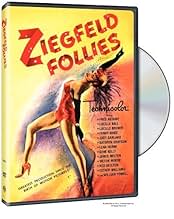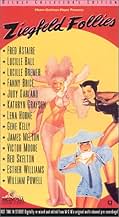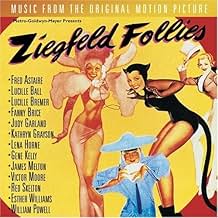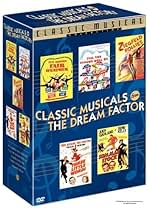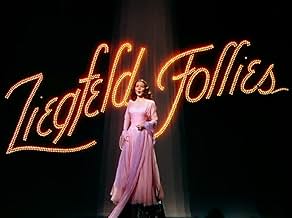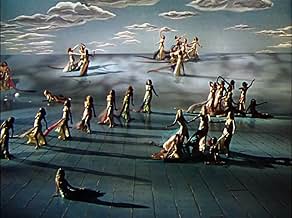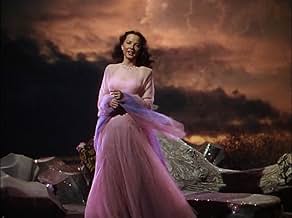IMDb-BEWERTUNG
6,4/10
3739
IHRE BEWERTUNG
Füge eine Handlung in deiner Sprache hinzuThe late, great impresario Florenz Ziegfeld Jr. looks down from Heaven and ordains a new revue in his grand old style.The late, great impresario Florenz Ziegfeld Jr. looks down from Heaven and ordains a new revue in his grand old style.The late, great impresario Florenz Ziegfeld Jr. looks down from Heaven and ordains a new revue in his grand old style.
- Auszeichnungen
- 1 Gewinn & 1 Nominierung insgesamt
Handlung
WUSSTEST DU SCHON:
- WissenswertesThe machine producing the bubbles for the finale was responsible for one of the greatest filming fiascoes in movie history. On the first day of filming the finale, the gas produced by the bubbles caused Vincente Minnelli's cameraman to faint on top of a forty foot lift. While Minnelli struggled to stop his cameraman from falling, the bubbles continued to pour from the machine to such an extent that the soundstage was flooded with bubbles, and no one could get close enough to turn the machine off. Eventually, the fire brigade was called to turn stop it. Afterwards, teams of workers used large rackets to keep them under control, but the gas from the bubbles remained a constant hazard, and between each take Minnelli would order the soundstage's doors open so the cast and crew could breathe. James Melton filmed with a wet handkerchief in his mouth to protect his voice. Fred Astaire and Lucille Bremer's dance was removed completely, since in every take of them, the bubbles obscured part of their face.
- PatzerTowards the end of the "This Heart of Mine" number, as Fred Astaire and Lucille Bremer begin to dance back to the palace, dancers in the background (screen left) clearly are struggling to stabilize some of the antler-tree props.
- Zitate
Florenz Ziegfeld Jr.: Children play with the dreams of tomorrow. And old men play with the memories of yesterday.
- Crazy CreditsZiegfeld Follies credits are in alphabetical order. That is why "Bunin" comes before "Charisse"
- Alternative VersionenThere is an Italian edition of this film on DVD, "FOLLIE DI ZIEGFELD", re-edited in double version (1.33:1 and 1.78:1) with the contribution of film historian Riccardo Cusin This version is also available for streaming on some platforms.
- VerbindungenEdited into Hollywood: The Dream Factory (1972)
- SoundtracksHere's to the Girls
Music by Roger Edens
Lyrics by Arthur Freed
Sung by Fred Astaire, chorus
Danced by Cyd Charisse, Lucille Ball, chorus
Ausgewählte Rezension
If you're watching ZIEGFELD FOLLIES expecting a plot of any kind, or even an attempt at one, you'd probably be quite horrifically let down by this film. It's best to approach and accept it for what it is--a crazy filmic patchwork of song and dance and sketches, with some that undoubtedly work better than others, and some that are best left forgotten in the annals of film history. If you *do* bear this in mind, ZIEGFELD FOLLIES is an amusing way to spend a couple of hours as you watch these famous stars, including Fred Astaire, Lucille Ball, Gene Kelly, Judy Garland and many many more trying their utmost best to entertain you. (Admittedly, some with better success than others!)
The film opens with William Powell as Florenz Ziegfeld (reprising his role in THE GREAT ZIEGFELD for what really amounts to a cameo), looking down from heaven as he plans to put up one last, great Ziegfeld follies using the best stars of the day. What immediately follows is the trademark very very pink number, with girls galore floating by on merry-go-round horses, that segues into a rather surreal bit with Lucille Ball (properly attired in a pink fluffy concoction) brandishing a whip (oh dear) against several girls in very sexily-cut black leather body suits. It's an... interesting way to kick the film off, let's leave it at that.
There's no real way to summarise ZIEGFELD FOLLIES except by singling out one's own favourite numbers. And in the forest of boring (Keenan Wynn wastes his talents in a grating and predictable phone sketch), over-the-top (feast your eyes on Esther Williams' water ballet or Kathryn Grayson's operatic warbling as Cyd Charisse dances through bubble mountains) and just plain weird (Judy Garland performing what could well be the first rap in Classic Hollywood--it's not an altogether pretty picture), all of Astaire's contributions to the film stand out.
Astaire is the ostensible star of the film, appearing no less than four times with three gorgeous dance sequences that could certainly count among his personal best. In two of them he's partnered with Lucille Bremer to pleasing effect. "This Heart Of Mine" features Astaire in his rogue persona as he romances Bremer with dance (doesn't he always?) only to steal her jewelry... and for her to steal his heart. The better of their collaborations is the odd but intriguing "Limehouse Blues" with the two of them made up like Chinese (Astaire almost--*almost*--carries it off but ends up looking a little silly). Leaving aside stereotypes, the ballet in Tai Long's fevered dreams is quite stunning, and impeccably staged. I'm still trying to figure out how Astaire and Bremer managed to remember the exact way in which to flip their fans... I hate to think how many times they must have reshot that just to get it all perfectly synchronised!
My favourite number in ZIEGFELD FOLLIES, small surprise, is the one I was looking out for: the penultimate number, "The Babbitt & The Bromide", featuring Astaire and Kelly together on screen, performing the same routine for once in their long illustrious careers. It's a funny little number, with the two fellows they play meeting each other at every stage of their lives, only to have the same inane, mundane conversation. Then follows a small bout of onemanupship as they try to out-dance the other, right into the gates of Heaven. Watching them together is a real treat, because you know these are probably the two best dancer/singer/actors ever committed to film. It's a bit of a shame that their styles don't quite gel: Astaire floats his way through the routine as Kelly pounds the ground as only he can, so their dancing is polished, in perfect time (the timing is absolutely amazing!), but just a little bit off-kilter. It's still the best number in ZIEGFELD FOLLIES though, with Kelly's irrepressible mischief playing against Astaire's ruffled charm.
ZIEGFELD FOLLIES is really just a big, sparkly candy box of a movie--if you bear in mind that a plot was never particularly high on the mind of writers, producers, or directors, and you have a good book by your side to tide you through the (fortunately not too numerous) stretches of boredom, you're set for the evening. Keep the video ready for whenever Astaire breaks onto the screen; that's always a sign of quality. 7/10
The film opens with William Powell as Florenz Ziegfeld (reprising his role in THE GREAT ZIEGFELD for what really amounts to a cameo), looking down from heaven as he plans to put up one last, great Ziegfeld follies using the best stars of the day. What immediately follows is the trademark very very pink number, with girls galore floating by on merry-go-round horses, that segues into a rather surreal bit with Lucille Ball (properly attired in a pink fluffy concoction) brandishing a whip (oh dear) against several girls in very sexily-cut black leather body suits. It's an... interesting way to kick the film off, let's leave it at that.
There's no real way to summarise ZIEGFELD FOLLIES except by singling out one's own favourite numbers. And in the forest of boring (Keenan Wynn wastes his talents in a grating and predictable phone sketch), over-the-top (feast your eyes on Esther Williams' water ballet or Kathryn Grayson's operatic warbling as Cyd Charisse dances through bubble mountains) and just plain weird (Judy Garland performing what could well be the first rap in Classic Hollywood--it's not an altogether pretty picture), all of Astaire's contributions to the film stand out.
Astaire is the ostensible star of the film, appearing no less than four times with three gorgeous dance sequences that could certainly count among his personal best. In two of them he's partnered with Lucille Bremer to pleasing effect. "This Heart Of Mine" features Astaire in his rogue persona as he romances Bremer with dance (doesn't he always?) only to steal her jewelry... and for her to steal his heart. The better of their collaborations is the odd but intriguing "Limehouse Blues" with the two of them made up like Chinese (Astaire almost--*almost*--carries it off but ends up looking a little silly). Leaving aside stereotypes, the ballet in Tai Long's fevered dreams is quite stunning, and impeccably staged. I'm still trying to figure out how Astaire and Bremer managed to remember the exact way in which to flip their fans... I hate to think how many times they must have reshot that just to get it all perfectly synchronised!
My favourite number in ZIEGFELD FOLLIES, small surprise, is the one I was looking out for: the penultimate number, "The Babbitt & The Bromide", featuring Astaire and Kelly together on screen, performing the same routine for once in their long illustrious careers. It's a funny little number, with the two fellows they play meeting each other at every stage of their lives, only to have the same inane, mundane conversation. Then follows a small bout of onemanupship as they try to out-dance the other, right into the gates of Heaven. Watching them together is a real treat, because you know these are probably the two best dancer/singer/actors ever committed to film. It's a bit of a shame that their styles don't quite gel: Astaire floats his way through the routine as Kelly pounds the ground as only he can, so their dancing is polished, in perfect time (the timing is absolutely amazing!), but just a little bit off-kilter. It's still the best number in ZIEGFELD FOLLIES though, with Kelly's irrepressible mischief playing against Astaire's ruffled charm.
ZIEGFELD FOLLIES is really just a big, sparkly candy box of a movie--if you bear in mind that a plot was never particularly high on the mind of writers, producers, or directors, and you have a good book by your side to tide you through the (fortunately not too numerous) stretches of boredom, you're set for the evening. Keep the video ready for whenever Astaire breaks onto the screen; that's always a sign of quality. 7/10
Top-Auswahl
Melde dich zum Bewerten an und greife auf die Watchlist für personalisierte Empfehlungen zu.
- How long is Ziegfeld Follies?Powered by Alexa
Details
- Erscheinungsdatum
- Herkunftsland
- Sprache
- Auch bekannt als
- Ziegfeld Follies of 1944
- Drehorte
- Produktionsfirma
- Weitere beteiligte Unternehmen bei IMDbPro anzeigen
Box Office
- Budget
- 3.240.816 $ (geschätzt)
- Laufzeit1 Stunde 25 Minuten
- Farbe
- Seitenverhältnis
- 1.37 : 1
Zu dieser Seite beitragen
Bearbeitung vorschlagen oder fehlenden Inhalt hinzufügen

Oberste Lücke
By what name was Broadway-Melodie 1950 (1945) officially released in India in English?
Antwort

